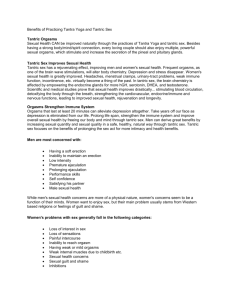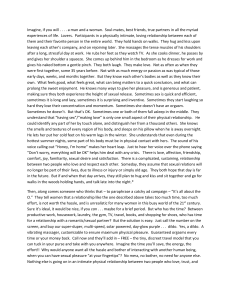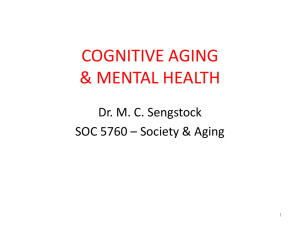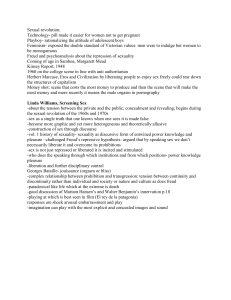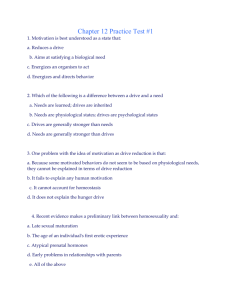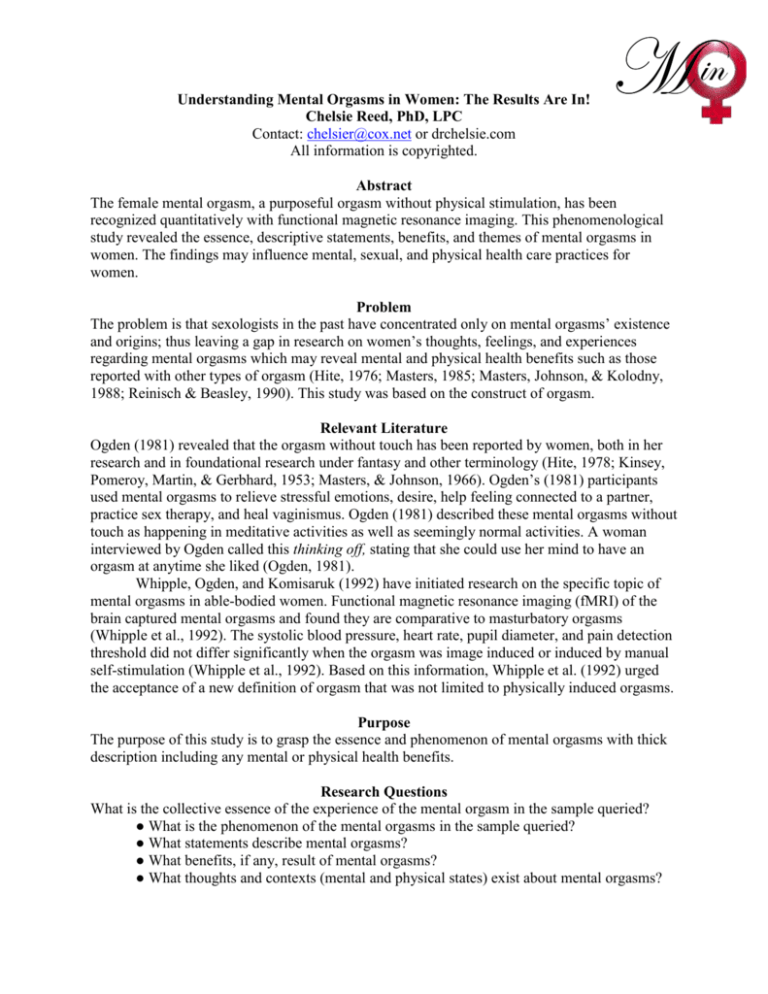
Understanding Mental Orgasms in Women: The Results Are In!
Chelsie Reed, PhD, LPC
Contact: chelsier@cox.net or drchelsie.com
All information is copyrighted.
M in
Abstract
The female mental orgasm, a purposeful orgasm without physical stimulation, has been
recognized quantitatively with functional magnetic resonance imaging. This phenomenological
study revealed the essence, descriptive statements, benefits, and themes of mental orgasms in
women. The findings may influence mental, sexual, and physical health care practices for
women.
Problem
The problem is that sexologists in the past have concentrated only on mental orgasms’ existence
and origins; thus leaving a gap in research on women’s thoughts, feelings, and experiences
regarding mental orgasms which may reveal mental and physical health benefits such as those
reported with other types of orgasm (Hite, 1976; Masters, 1985; Masters, Johnson, & Kolodny,
1988; Reinisch & Beasley, 1990). This study was based on the construct of orgasm.
Relevant Literature
Ogden (1981) revealed that the orgasm without touch has been reported by women, both in her
research and in foundational research under fantasy and other terminology (Hite, 1978; Kinsey,
Pomeroy, Martin, & Gerbhard, 1953; Masters, & Johnson, 1966). Ogden’s (1981) participants
used mental orgasms to relieve stressful emotions, desire, help feeling connected to a partner,
practice sex therapy, and heal vaginismus. Ogden (1981) described these mental orgasms without
touch as happening in meditative activities as well as seemingly normal activities. A woman
interviewed by Ogden called this thinking off, stating that she could use her mind to have an
orgasm at anytime she liked (Ogden, 1981).
Whipple, Ogden, and Komisaruk (1992) have initiated research on the specific topic of
mental orgasms in able-bodied women. Functional magnetic resonance imaging (fMRI) of the
brain captured mental orgasms and found they are comparative to masturbatory orgasms
(Whipple et al., 1992). The systolic blood pressure, heart rate, pupil diameter, and pain detection
threshold did not differ significantly when the orgasm was image induced or induced by manual
self-stimulation (Whipple et al., 1992). Based on this information, Whipple et al. (1992) urged
the acceptance of a new definition of orgasm that was not limited to physically induced orgasms.
Purpose
The purpose of this study is to grasp the essence and phenomenon of mental orgasms with thick
description including any mental or physical health benefits.
Research Questions
What is the collective essence of the experience of the mental orgasm in the sample queried?
● What is the phenomenon of the mental orgasms in the sample queried?
● What statements describe mental orgasms?
● What benefits, if any, result of mental orgasms?
● What thoughts and contexts (mental and physical states) exist about mental orgasms?
● What themes emerge about mental orgasms?
Data Collection Methods
This qualitative phenomenological study was formed by the hermeneutical (van Mannen, 1990),
transcendental (Creswell, 2007), and feminist (Olesen, 2005) paradigms shaped the study. Ten
self-defined women who used mental orgasms for 1 year or longer were interviewed using a
interview worksheet to provide consistent open-ended questions (Levin, 2004). The interviews
were all digitally recorded along with field notes and a researcher’s journal to allow for the data
emergence to be transparent (Creswell, 2007). The recordings were transcribed and member
checked for accuracy.
Data Analysis Approaches
The transcriptions along with the voice recordings, field notes, and researcher’s journal were
analyzed using NVivo 8. The researcher coded with free nodes, then reduced and organized into
tree nodes and sets as appropriate. Textural and structural descriptions emerged to then describe
the essence of mental orgasms and answer the research questions.
Findings
These findings are a brief synopsis – please see the whole dissertation for a full report.
Participant Profiles
This study sought after self defined women who report using purposeful orgasms by
thought alone for over 1 year and live in Arizona. The women were referred by posters in
meditation and sexology offices, word of mouth, and email. The participants were a
homogeneous group composed of 10 White, divorced now single, women from ages 46 (P1) to
65 (P4) with average age of 53. All but one woman (P3) have had children with a mode of 2 and
average of 1.8 children. All participants have had sex with men primarily, and were not
questioned about their sexual orientation. All have used a variety of contraceptives and barriers
for protection from pregnancy and sexually transmitted diseases. All are multiply orgasmic with
multiple orgasm types; one having counted 103 orgasms in one sexual encounter with a partner
(P10). Committed relationships were ranging from 2-6 partners with an average of 4.8.
Consensual coitus began for the women at age 14 (P3), 16 (P9, P10), 17 (P2, P6, P7, P8,) and 20
(P5). All women have had teachings in tantric and/or shamanism though all have different
experiences and time invested in the teachings.
Phenomenon
The phenomenon of mental orgasms seeks to understand what a mental orgasm is, when and
where is it occurring, and how it comes about.
Description. Mental orgasms were defined by all the women as very similar, or the same,
as physically induced orgasms. Mental orgasms were expressed as being just another type of
orgasm, having their own differences “Very much the same as a physical one. Really, there is not
that much difference” (P1), and the experience was depicted as very much a physical response
caused by mental stimulation:
Well they (mental orgasms) still, they seem like when they start, it still starts at my root
chakra. So the first thing I’m aware of is the scent of a heater warm like a tingling at the
base in my root. In my, even in my, in the kind of, well it actually starts, not really
starting (at) my clitoris, but starting inside like really right at the base of the spine but
then you know, very quick, it’s like a vibration. Or should I say, it’s a little hard to say
because it’s not exactly a physical vibration but there is a movement. There is a
movement of energy. And then it begins to kind of like stand out to words and then I
connect with my clitoris and I feel my whole pelvis get warm and um filled with
pleasure… like a vibration. And then it’s usually but as soon as that is happening there’s
um naturally without thinking about there is a tendency to want to squeeze, you know the
PC (pubococcygus muscle) just kind of spontaneously begin to pulsate and then that as
soon as that happens, then there is like well then, this is my spine will automatically
starts moving and then it starts going up to. (P8)
The women distinguished mental orgasms from physically induced orgasms due to their ability
to change and control the mental orgasms to be as intense they would like them to be (P2, P3, P6,
P7, P8, P9, P10):
What I found with mental orgasms is that you can vary them by what you’re
thinking…So you can like make them as intense as you want them to be. You can make
them as engulfing as you want them to be or you can make them as mellow as you want
them to be…Just exactly what you want. (P2)
Unlike physically induced orgasms which were portrayed by all women as discrete and only
lasting while the stimulation continued, mental orgasms are characterized as lasting anywhere
from a quick moment to days of being in an orgasmic state (P3, P8, P9, P10).
When and where. When asked about when and where mental orgasms occur, the women
all agreed on anytime, anyplace “When and where don’t I?” (P3). This women all stated they
have mental orgasms while alone at home and other places and times including examples of
while enjoying ambiance of candlelight (P3, P10), driving (P1, P2, P10), at work (P2, P3, P10),
talking to people (P2), in tantra class (P5, P6), hot yoga class (P6), on a walk or outdoors (P3,
P7, P9, P10), dancing (P7), meditation (P7), music (P7), shopping (P2), spinning class (P7), and
swimming (P7). The women recognized they were picking and choosing examples and would
not be able to compile a complete list of where and when they have mental orgasms “mental is
really the way to go. At the moment, that’s an anytime anywhere kind of thing, so I use that in
lieu of other forms of self stimulation” (P10).
With stimulation. The women recapitulated that even though mental orgasms are not
derived from physical stimulation, they can exist along with physical stimulation:
I really realized just how much ecstasy I could contain and generate without having to be
touching myself or doing anything sexual. Like I remember, one morning and going in
and just eating a bite of toast, I was like ‘oh my god, I am having a toast orgasm! What
type of bread is this? I have to get this bread!’ And then later of course it had nothing to
do with the bread. Because I was just senses open in an ecstatic state where tasting food
or drinking a cup of tea or just taking up a cup of tea and I get to feel like ha, ha, ha, just
smelling it…anything or every little thing. It was like everything. (P8)
Furthermore, with direct genital stimulation “I mean that’s not bad (the spinning bike rubbing on
her genitals). I don’t avoid that. But it’s not because of that” (P7). As well with partnered sex and
foreplay (P1, P4, P5).
How. A common theme of not using or creating, but allowing a mental orgasm was
stipulated throughout the interviews “I was allowing them. I don’t know how come the word use
does not fit; it’s a funny way to think about it. It is allowing” (P5). The women chose the words
“allow” (P3, P5, P6, P9), “let” (P3, P4, P6), “choose” (P4, P10), “tap into” (P5, P8), “turn on”
(P10), “pick up on” (P5), “recognize” (P5), “decide” (P6), “go there” (P7), and “bring attention
to” (P8) for describing how they achieve mental orgasms. There was not a protocol, it is simply
allowed:
It’s so interesting because I, I don’t know exactly. It’s not like something I create exactly.
It’s more like something that’s always there but I just have to bring my attention to it and
then I’m aware it. I think it’s more like that because it’s more like it’s not like I have to
say oh, I got to make this happen and then I do something. It’s more like, oh, I want to
connect with this energy and it’s kind of like, it’s kind of like hot water out of the sink.
It’s like you don’t have to go out and build the fire and haul the bucket and put them on
there to make the water hot. I mean you just have to do that. I had to do that in my life.
I’ve lived where I had to do that to make hot water but now I just go over there and make
it. And I turn on the tap and hot water comes out. (P8)
First mental orgasm. None of the women report being taught to mental orgasm. One
specified that she was taught tantric breathing, though the mental orgasm was separate form that
experience (P4). The women illustrated a variety of first time experiences with fantasy (P1, P2,
P6, P10):
That was the first mind orgasm that I was aware of when I was a sophomore was
thinking about a horse. Actually, I think I was actively thinking about it. It was a really
cool horse and it was like some hope that possibly I would be able to buy him. (P6),
it just happening (P7, P8, P9) “They just would happen” (P7), and meditation (P3, P4, P5) “I
was just I was really getting into a level of relaxation that was really knew I call it ‘meditative
relaxation’ when you just stop and really give your body a break. And it just started happening”
(P4). The age of mental orgasm onset is quite varied from teens (P1, P6, P10), 20s (P7), 30s (P2,
P3), 40s (P8, P9), and 50s (P4, P5). Half the women had their first mental orgasm before
childbirth (P1, P3, P6, P7, P10) and half after child birth (P2, P4, P5, P8, P9).
Benefits
It was predicted that the women would have some of the benefits of orgasm that have
been recognized with physical orgasm including tension release, stress release, and pain
management.
Personal. All women conveyed using mental orgasms while alone to ease sexual tension
“Mental is really the way to go. At the moment, that’s an anytime anywhere kind of thing, so I
use that in lieu of other forms of self stimulation” (P10). The women revealed that mental
orgasms make them feel good about themselves, and about doing something that provides a
sense of safety and security while also being loving and good for themselves, and having
fulfillment (P1, P2, P3, P5, P7, P6, P8, P10) “I think it (mental orgasms) makes it (life) more
fulfilling. I think you become more confident, more independent because this is something that
you’re doing within yourself” (P2). They also describe being more sexually confident because of
mental orgasms (P2, P3, P5, P6, P8, P9, P10):
Oh it (mental orgasms) puts a whole different stride in your step. You know you get that
‘grrrrr’ you get that uhm, -it just gives you a different confidence, (it) gives you a
different uhm energy, a different mannerism. (P2)
Health. The women all declared mental orgasms help with their “health” and half specify
that mental orgasms help with “pain” (P2, P3, P5, P7, P10). The women made clear that mental
orgasms have been used for emotional pain (P1, P3, P5, P6, P7, P9, P10) including grief,
depression, guilt, shame, and hurt. The use of mental orgasms for the release of tension, stress,
and anxiety (P1, P2, P3, P4, P6, P7, P8, P10) was a very common message including relieving
“dis-ease” (P5, P10). Even specifically calling mental orgasms “medicine” (P5, P9, P10), and
being a “cleanse” or “detox” (P3, P7, P9, P10). Three note using mental orgasms for headache or
migraine relief (P2, P8, P10):
Well, I think they’re like medicine. They are a replacement for pharmaceuticals for sure.
And, they’re certainly less toxic or contraindicated than herbs that might be used in the
wrong sequence or combination. So, to me, movement of energy is exactly what we are
and what we should probably use to find good states of health. I mean, cancerous cells
can’t live in a harmonious environment. So… intention plus alkalinity oxygenation, or
whatever you want to call it as having that energetic body at it's maximum is the way that
you combat dis-ease. (P10)
Figure 1. Reported benefits of mental orgasms.
Partnered. The women recounted knowing about or using mental orgasms to help with
partnered sex to enhance it (P1, P2, P4, P5, P9, P10)
If I had a bad lover, I mean, I could certainly still have a great time, just by tapping into
myself. But, it was more knowing that I had this quality. And, to me, that’s a pretty good
bit of ammo in my pocket. So, I can just pull it out and utilize it at any time. (P10)
Thoughts and Contexts
The subquestion What thoughts and contexts (mental and physical states) exist about mental
orgasms? asks for an explanation of who these women are and under what circumstances,
physical and metal states, do they and mental orgasms exist.
Current satisfaction. The women were all asked about present satisfaction in sex life
and then sexuality. Sex life was labeled as “not satisfied” (P8, P10), “getting better” (P2), a “6 or
7” (P3), “alright” (P6), “B+” (P5), “comfortable” (P7), “semi-satisfied” (P9) and “very satisfied”
(P1). Sex life satisfaction was consistently placed in the context of partnered sex:
It’s like a mixed bag. Part of me is very happy with where I am and the other part of me
is now, knowing where I am, I'm not satisfied. So that means I know a lot more about me,
how I get excited, how I can get my energy going, what it takes to get my energy going,
and the lack of partners to do that. Partnering is still important to me. So it’s interesting,
but my greatest energetic involvement does come with partnering, and my partners are
not up to it. And my teaching has not been enough. So I would say – how satisfied am I?
I guess I must say a lot of dissatisfaction. (P4)
Sexuality satisfaction was expounded unanimously as high and was described as an internal, and
personal attribute specifically as “very satisfied” (P1, P6, P7, P8), at “about 80%” (P3, P4),” love
it” (P2, P9), at “100%” (P5), and “very comfortable” (P10). The women elaborated that sexuality
was separate from sex life due to the personal role and expression “at this point my sexuality is
my greatest gift and I'm learning that there are many ways to share sexuality without necessarily
having sex with someone” (P9).
Female ejaculation. Eight of the ten participants (P1, P2, P3, P4, P5, P6, P9, P10)
revealed having female ejaculation when asked to describe their orgasms. The women had
different experiences with their first time ejaculating, though all now expressed enjoying and
accepting their ejaculation as part of their normal sexual response.
Self pleasuring. The age of masturbation onset was quite varied from women
masturbating before age 10 (P3, P5, P6, P8) with the earliest being age 2, between ages 10-19
(1P, 9P, 10P), and at age 20 (P2, P7) with one who did not mention age of masturbation onset
(P4). The women all expounded on using objects and sex toys during masturbation and
sometimes with partnered sex. The toy use included anal plugs (P4), cucumbers (P1), dildos (P2,
P3, P5, P6, P8, P10), eggs (P3, P7), feathers (P10), horseback riding (P6), lipstick (P5), pillows
(P3), stuffed animals (P3), scarves (P10), swing sets (P10), tetherball poles (P1), vibrators (P1,
P2, P3, P4, P5, P6, P7, P8, P9), wine bottles (P1), water jets or sprays (P5, P6, P8, P9), and
zucchinis (P7). The toy use was part of masturbation for release:
Nocturnal orgasms. All women communicated having nocturnal orgasms and most
remembered them being during their teens, 20s, and 30s (P1, P2, P4, P5, P6, P7, P8, P10).
Prolonged arousal. The women vividly recounted that their sexual arousal and orgasmic
state could be elongated and enjoyed for hours and even days at a time by allowing it and often
call it an ecstatic state (P3, P4, P6, P7, P8, P9, P10):
Sometimes it’s just kind of a quickie, whereas the mental can be an ongoing thing. I can
be in a state of arousal for a half a day at a time, or what have you. So, that’s probably the
preferred method. It feels better. (P10)
Mental orgasms in public. The women expressed having had mental orgasms out in
public and that they think others cannot tell they are having an orgasm due to their ability to
control it and it being an internal response (P1, P2, P3, P6, P7, P8, P9, P10):
No I’m much more discrete about it (mental orgasm). It’s more in my head than anything.
Sometimes when I just want to be distracted. Yes, they might think I’m zoning out on
them though…And you can have it and nobody knew that you could be in a room full of
people and they may not even know what you know but it’s you’re like thing plus I love
it. (P2)
Themes
The remaining subquestion What themes emerge about mental orgasms? asks for other
information and insights that the data revealed. As the research was analyzed, many themes
emerged. These themes were not directly questioned and are a result of the women simply
expressing their full experience.
Partners. All the women explained wanting a partner who is of quality to share their
lives with, not just sex, and that they are willing to wait for a good relationship and not settle for
less:
Yeah I think it’s not the lover, as much for the, it’s not so much for the sexual satisfaction
although you know of course it’s nice but it’s more the, it’s somebody to spend my life
with you know, it’s more that. To spend my life with. It’s more like, it’s not so much any
of the men that give me orgasms, so I can give myself orgasm you know, but if anything I
just say “yeah, yea, oof’ and it is really real. So a man is probably not going to do that for
me. But I cannot sit down and eat with my orgasm. I cannot like go on a vacation and yes
it goes with me but it’s not the same and there’s not that mutual sharing and someone to
dream with and do things with. Just someone to share your life with, snuggle up with just
a real practical human need of connection. (P8)
The women expressed concern that they believe sexual partners, men, may be intimidated by
their advanced sexuality (P1, P2, P3, P8, P9, P10), while other men may be excited or enjoy it
(P5, P6, P8, P9, P10):
My fears have been its intimidating for a lot of men, if she can be kinda of be orgasmic
without having him to touch you, it kind of like why do you need me around. You know I
found, and then I had that experience quite a few times. With men who are kind of put off
by my ability to be orgasmic just in a whim. So I guess. And I think I can also get
varying, I can be very responsive and they have it really done a lot to, they realize they
are not the ones who is making me feel pleasure. I guess, you know, how to be in that
state and so somehow it seems like it creates some sense of inadequacy often. (P8)
Should use mental orgasms more. Some of the women conveyed that even though they
enjoy mental orgasms, like the benefits and effects, they do not allow them often enough and
need to allow them more often (PP4, P6, P8, P9):
What I'm mostly aware of, how do I say it, after I've had all of these orgasms I feel so
clean inside and I feel that my energy is integrated and moving and it reminds me of how
much of the time, how most o my life I was pent up, and stressed out and not integrated
in it. So, even though it feels so much better after, I also still have that tendency to get all
stressed out and not let others to move in me and be a part of my own. . . I need to just do
this more. I need to have this be like my daily therapy and not just let energy move.
Because what I noticed even last night I was feeling lousy and then after I had a few
orgasms I felt wonderful and yet it still hasn't been clicking. (P9)
Dissemination of mental orgasms. Many of the women imparted that the ability to
mental orgasm needs to be spread and taught so that more people, men and women, can enjoy
the benefits and effects (P3, P5, P6, P8, P9, P10):
I just feel like it’s a strength and it’s a tool that there’s a wonderful thing to have and I’d
love to have everyone else see that they’ve got it too. And, maybe that’s part of my
teaching and being in the tantric and sex education community is wanting to share that
because it’s such a great thing. It takes away some of the misery of living in this
structured, dogmatic life that has limitations. (P10)
Implications for Social Change
Physicians, mental health professionals, and sex therapists can view mental orgasms as a
possible treatment to help with stress, tension, physical pain, inorgasmia, and sexual inhibition.
The research did not specifically show effects of mental orgasms, though the data is very
supportive of mental orgasms being another venue for orgasmic mental and physical health
benefits. Mental orgasms may be taught to individuals and in group format to increase the
population gaining its positive effects. I teach mental orgasms at this time to individuals as a
supplementary treatment for inorgasmia, sexual inhibition, vaginismus, tension, stress, physical
pain, and sexual self-esteem. I would like to increase my teachings to more people and groups to
allow more people access to this ability and its effects.
References
Creswell, J. W. (2007) Qualitative inquiry & research design: Choosing among five approaches
(2nd ed.). Thousand Oaks, CA: Sage Publications.
Hite, S. (1976). The Hite report: A nationwide study of female sexuality. New York:
Seven Stories Press.
Hite, S. (1987). Women and love: A cultural revolution in progress. New York: Alfred A.
Knopf, Inc.
Kinsey, A. C., Pomeroy, W. B., Martin, C. E., & Gebhard, P. H. (1953). Sexual behavior in the
human female. Oxford: Saunders.
Komisaruk, B. R., Beyer-Flores, C., & Whipple, B. (2006). The science of orgasm.
Johns Hopkins University Press.
Levin, R. J. (2004). An orgasm is…who defines what an orgasm is? Sexual & Relationship
Therapy, 19(1) 101-107. doi: 10.1080/14681990410001641663
Masters, W. H. (1985). Masters and Johnson on sex and human loving / William H. Masters,
Virginia E. Johnson, Robert C. Kolodny. Boston: Little, Brown.
Masters, W. H., & Johnson, V. E. (1966). Human sexual response. London: J. & A. Churchill
Ltd.
Masters, W. H., Johnson, V. E., & Kolodny, R. C. (1988). Human Sexuality. Chicago: Scott,
Foresman and Company.
Ogden, G. (1981). Perception of touch in easily orgasmic women during peak sexual
experiences. San Francisco: Institute for Advanced Study of Human Sexuality.
Olesen, V. (2005). Early millennial feminist qualitative research: Challenges and
contours. In N. K. Denzin & Y. S. Lincoln (Eds.), The Sage handbook of
qualitative research (3rd ed., pp. 235-278). Thousand Oaks, CA: Sage
Publications.
Reinisch, J. M., & Beasley, R. M. (1990). The Kinsey Institute new report on sex: What you must
know to be sexually literate. New York: St. Martin's Press.
van Mannen, M. (1990). Researching lived experience: Human science for an action
sensitive pedagogy. London, Ontario, Canada: The University of Western
Ontario.
Whipple, B., Ogden, G., & Komisaruk, B. R. (1992). Physiological correlates of
imagery-induced orgasm in women. Archives of Sexual Behavior, 21(2), 121-133.

